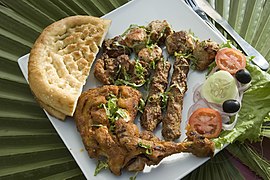Sohan halwa
Sohan halwa (Urdu سوہن حلوہ; [ˈsoːɦən ˈɦəlʋaː]) is a traditional dessert in South Asia, which is a variety of dense, sweet confection or halwa. Gheewala halwa is popular for sohan halwa since the Mughal era. There are hundreds of shops that produce sohan halwa in the cities of Multan (Punjab) and Dera Ismail Khan (Khyber Pakhtunkhwa), with a pioneering and passion of the dish going back decades.
A variation of the Sohan Halwa made as circular discs. | |
| Course | Dessert |
|---|---|
| Place of origin | West Asia and the Indian subcontinent |
| Main ingredients | cornflour, sugar, milk, water |
| Variations | Almonds |
| Other information | Halva |
It is made by boiling a mixture of water, sugar, milk, and cornflour until it becomes solid. Saffron is used for flavoring. Ghee is used to prevent it from sticking to the pan. Almonds, pistachios, and cardamom seeds are added. Unlike most other halwa dishes in the Indian subcontinent, it is solid, similar to its Middle Eastern counterparts.
History

The Hafiz Halwa shop in Multan claims it was introduced by Dewan Sawan Mal, the ruler of Multan in 1750. However, there is a theory that it was invented in Persia by Iranian people and it was considered an ancient sweet served during social gatherings.[1]
S. Abdul Khaliq claims that this halwa was introduced in the Indian subcontinent in the early 16th century when Mughal emperor Humayun (r. 1530–1540, 1555–1556) came back to power in Medieval India after being exiled in Herat, which was the capital of Persia.
In Old Delhi, the 225-year-old Ghantewala sweet shop established during the reign of Mughal Emperor Shah Alam II, (r. 1759 - 1806) in 1790, made Sohan Halwa, and remained a popular visitors attraction,[2][3] till its closure due to a lack of profitability hit the news July 23, 2015.[4]
Commercial production
Sohan has been commercially produced by traditional confectioners for decades. It is brittle and caramelised, usually made into discs of 5-6mm thickness or as square bite-size pieces. It is usually packaged in intricately designed tin cylinders. In recent years other packages have also been common.[5]
Notable brands
- Hafiz Sohan Halwa
- Bhutta Sohan Halwa Multan
- Abdul Wadood Sohan Halwa Multan
- Rewari Sohan Halwa
See also
- Baklava
- Basbousa
- Halva
- Pişmaniye
- Saray helva
- Shekarpareh
- Sohan (confectionery)
- Sohan papdi
References
- "- A Royal Sweet For Royal Palates". www.hafizhalwa.com.
- Planet, Lonely. "Restaurants in Delhi, India".
- The royal treat in Chandni Chowk The Hindu, Nov 07, 2002. Archived July 11, 2011, at the Wayback Machine
- "Ghantewala: Why did Delhi's 'oldest sweet shop' shut down?". 24 July 2015 – via www.bbc.com.
- Ramazani, Nesta (1997). Persian Cooking: A Table Of Exotic Delights. Ibex Publishers, Inc. p. 296. ISBN 978-0-936347-77-6.
- Usman, Nizam Ud Deen. "Multani Sohan Halwa". Multani Sohan Halwa.
